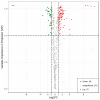Metabolomics Analysis Reveals Metabolites and Metabolic Pathways Involved in the Growth and Quality of Water Dropwort [ Oenanthe javanica (Blume) DC.] under Nutrient Solution Culture
- PMID: 37050085
- PMCID: PMC10097307
- DOI: 10.3390/plants12071459
Metabolomics Analysis Reveals Metabolites and Metabolic Pathways Involved in the Growth and Quality of Water Dropwort [ Oenanthe javanica (Blume) DC.] under Nutrient Solution Culture
Abstract
Water dropwort (Oenanthe javanica (Blume) DC.) is an important vegetable crop. Nutrient liquid culture has become an important cultivation method in the production of water dropwort. However, the effects of different nutrient solution cultivation methods on the growth and quality of water dropwort remains unclear. In this study, to screen the most suitable nutrient solution formula for the cultivation of water dropwort, the effects of different nutrient solution formulas (Hoagland, Cooper, Dutch greenhouse, Garden-style, Yamasaki and SCAU) on plant physiological and quality characteristics are investigated. The plant height, root length, water content (%), distribution rate of dry matter (%), chlorophyll, VC, flavonoid, total phenolic, DPPH and dietary fiber of water dropwort under different nutrient solutions were determined. According to the analytic hierarchy process (AHP) of the growth index and quality index of water dropwort under different nutrient solutions, the Yamazaki nutrient solution was considered to be the most suitable nutrient solution formula for water dropwort. To further confirm the differences of water dropwort under nutrient solution culture and soil culture, the broadly targeted metabolomics were performed. A total of 485 metabolites were detected in water dropwort under optimal nutrient solution and soil cultivation. Metabolomics analysis showed that flavonoids were the most abundant differential accumulated metabolites, and most flavonoids were up-regulated. A qRT-PCR assay indicated that the structural genes of the flavonoid biosynthesis pathway (PAL, C4H, CHS, CHI, F3H, DFR, UFGT) were significantly higher under the Yamasaki nutrient solution treatment. The current study provided a theoretical basis and technical guidance for the nutrient solution cultivation of water dropwort. Meanwhile, this study provides new insights into the study of flavonoids in water dropwort.
Keywords: Oenanthe javanica (Blume) DC.; gene expression; metabolites; nutrient solution culture.
Conflict of interest statement
The authors declare no conflict of interest.
Figures








Similar articles
-
Exploring optimal soil conditions for high-functional Oenanthe javanica (water dropwort) production.J Sci Food Agric. 2025 Mar 30;105(5):2910-2922. doi: 10.1002/jsfa.14059. Epub 2024 Dec 9. J Sci Food Agric. 2025. PMID: 39652676
-
Integrated morphological, metabolome, and transcriptome analyses revealed the mechanism of exogenous gibberellin promoting petiole elongation in Oenanthe javanica.Front Plant Sci. 2023 Jul 17;14:1225635. doi: 10.3389/fpls.2023.1225635. eCollection 2023. Front Plant Sci. 2023. PMID: 37528973 Free PMC article.
-
Integrative Analysis of Long- and Short-Read Transcriptomes Identify the Regulation of Terpenoids Biosynthesis Under Shading Cultivation in Oenanthe javanica.Front Genet. 2022 Apr 7;13:813216. doi: 10.3389/fgene.2022.813216. eCollection 2022. Front Genet. 2022. PMID: 35464839 Free PMC article.
-
Influence of Blanching on the Gene Expression Profile of Phenylpropanoid, Flavonoid and Vitamin Biosynthesis, and Their Accumulation in Oenanthe javanica.Antioxidants (Basel). 2022 Feb 26;11(3):470. doi: 10.3390/antiox11030470. Antioxidants (Basel). 2022. PMID: 35326120 Free PMC article.
-
A Review of Oenanthe javanica (Blume) DC. as Traditional Medicinal Plant and Its Therapeutic Potential.Evid Based Complement Alternat Med. 2019 Apr 1;2019:6495819. doi: 10.1155/2019/6495819. eCollection 2019. Evid Based Complement Alternat Med. 2019. PMID: 31057651 Free PMC article. Review.
Cited by
-
Selection of suitable reference genes for qPCR normalization in different developmental stages of Oenanthe javanica.Front Plant Sci. 2023 Dec 27;14:1287589. doi: 10.3389/fpls.2023.1287589. eCollection 2023. Front Plant Sci. 2023. PMID: 38205019 Free PMC article.
-
Identification and characterization of anthocyanins' composition and regulatory genes involved in anthocyanins biosynthesis in water dropwort (Oenanthe javanica).Planta. 2025 Mar 4;261(4):76. doi: 10.1007/s00425-025-04660-x. Planta. 2025. PMID: 40035850
References
-
- Liu J.X., Jiang Q., Tao J.P., Feng K., Li T., Duan A.Q., Wang H., Xu Z.S., Liu H., Xiong A.S. Integrative genome, transcriptome, microRNA, and degradome analysis of water dropwort (Oenanthe javanica) in response to water stress. Hortic. Res. 2021;8:262. doi: 10.1038/s41438-021-00707-8. - DOI - PMC - PubMed
-
- Park J.H., Cho J.H., Kim I.H., Ahn J.H., Lee J.C., Chen B.H., Shin B.N., Tae H.J., Yoo K.Y., Hong S., et al. Oenanthe Javanica Extract Protects Against Experimentally Induced Ischemic Neuronal Damage via its Antioxidant Effects. Chin. Med. J. 2015;128:2932–2937. doi: 10.4103/0366-6999.168063. - DOI - PMC - PubMed
-
- Kwon D., Yoon S., Carter O., Bailey G.S., Dashwood R.H. Antioxidant and antigenotoxic activities of Angelica keiskei, Oenanthe javanica and Brassica oleracea in the Salmonella mutagenicity assay and in HCT116 human colon cancer cells. BioFactors. 2006;26:231–244. doi: 10.1002/biof.5520260402. - DOI - PMC - PubMed
Grants and funding
- CX(21)3026/Jiangsu Agricultural Science and Technology Innovation Fund
- 32102368/National Natural Science Foundation of China
- 21KJB210008/Natural Science Foundation of the Jiangsu Higher Education Institutions of China
- JBGS[2021]017/Jiangsu seed industry revitalization project
- CARS-24/China Agriculture Research System
LinkOut - more resources
Full Text Sources

